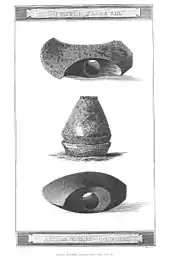Aston Valley Barrow Cemetery
The Aston Valley Barrow Cemetery, or Ashton Valley Barrow Cemetery, is a group of Bronze Age bowl barrow and bell barrow tumuli located on the south facing edge of Codford Down on the west side of the valley of the Chitterne Brook, and within the civil parish of Codford, in Wiltshire, England. There were originally ten bowl barrows and a single bell barrow, but some of these have now been ploughed out. Only the bell barrow and five bowl barrows currently survive.[1]
 Shown within Wiltshire | |
| Alternative name | Ashton Valley Barrow Cemetery |
|---|---|
| Location | Wiltshire |
| Region | Southern England |
| Coordinates | 51.1853°N 2.0301°W |
| Type | Barrow cemetery |
| History | |
| Material | Chalk |
| Periods | Bronze Age |
| Site notes | |
| Archaeologists | Sir Richard Colt Hoare, W.F.Cunnington, L.Grinsell, Rev.E.H.Steele |


Context
The site lies in close proximity to Codford Circle, an Iron Age hillfort or enclosure some 2 km (1.2 mi) to the southeast, and Knook Castle, an Iron Age hillfort a similar distance to the northwest.
Archaeology
Excavations at the barrows have revealed many Bronze Age and some possible Saxon urned cremations and other interments. The barrows were originally excavated by W.F. Cunnington in 1801, and recorded by Sir R. Colt-Hoare, with later excavations by the Reverend E.H. Steele in 1957; and with further correlations by Leslie Grinsell, also in 1957. Some burials and items were left in place by Cunnington, but others are now preserved at the Wiltshire Museum in Devizes.[1]
The excavations by Colt-Hoare and Cunnington in the 1800s revealed most of the finds and interments. However, as the three-age system had not yet been introduced, and they were unable to properly date their finds, they were at a disadvantage when trying to interpret them.
The following table includes details for the eleven barrows and associated finds:
| Name/reference | Location | Type | Size | NMR number | Description and finds |
|---|---|---|---|---|---|
| Barrow A Monument no.887655 |
grid reference ST97914268 | Bowl barrow | 23.5 m (25.7 yd) wide by 2.2 m (7.2 ft) high | ST 94 SE 54 | The largest barrow in the cemetery. Finds included cremated remains of a primary burial within a large urn and other secondary remains including nine smaller cremation urns, sherds and burnt bones.[2] |
| Barrow B Monument no.887681 |
grid reference ST97914274 | Bowl barrow | 20 m (22 yd) wide by 1.0 m (3.3 ft) high | ST 94 SE 55 | Contained a probable Bronze Age cremation.[3] |
| Barrow C Monument no.887692 |
grid reference ST97914277 | Bowl barrow | 15.5 m (17.0 yd) wide by 0.3 m (0.98 ft) high | ST 94 SE 56 | No finds.[4] |
| Barrow D Monument no.887703 |
grid reference ST97894280 | Bell barrow | 22.5 m (24.6 yd) wide by 2.8 m (9.2 ft) high | ST 94 SE 57 | Surrounding quarry ditch 5 m (5.5 yd) wide and 0.5 m (0.55 yd) deep. Contained a cremation beneath an inverted Bronze Age urn along with a perforated dolerite battle-axe or hammer.[5] |
| Barrow E Monument no.887709 |
grid reference ST97874277 | Bowl barrow | 21 m (23 yd) wide by 0.4 m (1.3 ft) high | ST 94 SE 58 | Contained a primary cremation along with a granodiorite battle axe and a bone point.[6] |
| Barrow F Monument no.887713 |
grid reference ST98044280 | Bowl barrow | 30 m (33 yd) wide by 1 m (3.3 ft) high | ST 94 SE 59, ST 94 SE 60 |
Contained a primary cremation and a later Saxon inhumation along with a fir-wood bucket bound with bronze, and a possible sword or spearhead.[7] |
| Barrow G Monument no.887718 |
grid reference ST97954269 | Bowl barrow | now ploughed out | ST 94 SE 61 | Contained a circular shaft with a nearby possible cremation, and other secondary cremations with urn fragments.[8] |
| Barrow H Monument no.887751 |
grid reference ST97904290 | Bowl barrow | now ploughed out | ST 94 SE 62 | Contained a human burial in a wooden coffin.[9] |
| Barrow J Monument no.887757 |
grid reference ST97844280 | Bowl barrow | now ploughed out | ST 94 SE 63 | Contained a cremation within a crushed urn.[10] |
| Barrow K Monument no.888063 |
grid reference ST97864280 | Bowl barrow | now ploughed out | ST 94 SE 64 | Contained a cremation (possibly two) within urns.[11] |
| Barrow L Monument no.888065 |
grid reference ST97884279 | Bowl barrow | now ploughed out | ST 94 SE 65 | Contained a cremation within a crushed urn.[11] |
References
- Historic England. "Ashton Valley (211332)". PastScape. Retrieved 22 April 2012.
- Historic England. "Monument No. 887655". PastScape. Retrieved 22 April 2012.
- Historic England. "Monument No. 887681". PastScape. Retrieved 22 April 2012.
- Historic England. "Monument No. 887692". PastScape. Retrieved 22 April 2012.
- Historic England. "Monument No. 887703". PastScape. Retrieved 22 April 2012.
- Historic England. "Monument No. 887709". PastScape. Retrieved 22 April 2012.
- Historic England. "Monument No. 887713". PastScape. Retrieved 22 April 2012.
- Historic England. "Monument No. 887718". PastScape. Retrieved 22 April 2012.
- Historic England. "Monument No. 887751". PastScape. Retrieved 22 April 2012.
- Historic England. "Monument No. 887757". PastScape. Retrieved 22 April 2012.
- Historic England. "Monument No. 888063". PastScape. Retrieved 22 April 2012.
Further reading
- Wiltshire Museum finds records for the Ashton Valley Barrow Group